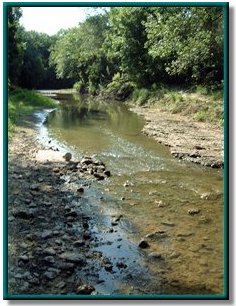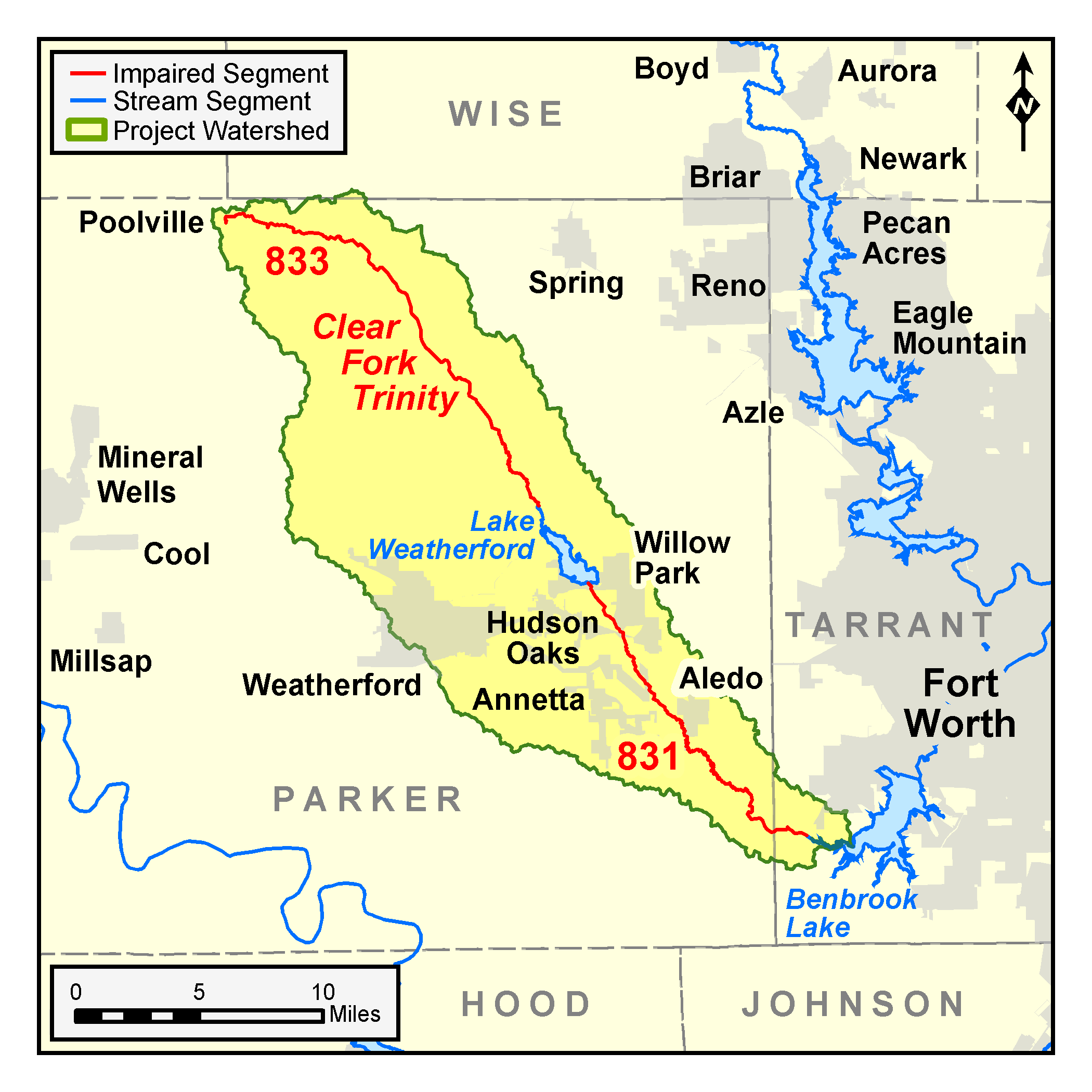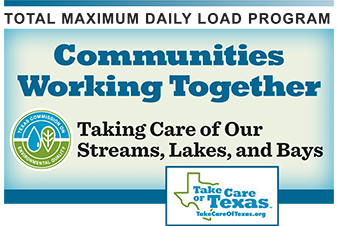Clear Fork Trinity River
Counties: Parker, Tarrant
Parameter: Dissolved oxygen
River Basin: Trinity
Segments: 0831, 0832
On this page:
- Watershed Description
- Background and Goals
- Participation
- Status
- Final Report
- Contact the TMDL Program
Watershed Description
This project focused on the two uppermost river segments of the Clear Fork Trinity River: Clear Fork Trinity above Lake Weatherford (Segment 0833) and Clear Fork Trinity below Lake Weatherford (Segment 0831). Both watersheds were predominantly rural; however, rapidly increasing urban populations were changing the landscape of the watershed.
Clear Fork Trinity above Lake Weatherford originates in far northwest Parker County about two miles upstream of FM Road 1707, and flows southeast 22 miles. At the time this project was carried out, the segment's watershed was mostly rural, with large areas of oak woods and prairies. The community of Poolville was the only developed area.
Flow in the upper portion of the segment is highly dependent on rainfall, and as a result, is often intermittent or absent—especially during summer. Flow in the lower portion of the segment is more consistent. The lower portion may be influenced by a natural spring.
Clear Fork Trinity below Lake Weatherford begins at Weatherford Dam in central Parker County and flows 19 miles. The segment's watershed was mostly blackland prairie and included the communities of Aledo, Weatherford, and Willow Park.
Flow in this segment seemed to be perennial in most years, although low-flow conditions in the upper segment commonly occurred. Stream flows increased in the lower portion because of inflows from the South Fork Trinity River. Like the area above Lake Weatherford, this watershed was predominately rural; however, rapidly increasing urban populations were changing the landscape of this watershed.
Background and Goals
Water quality assessment in 2002 indicated that concentrations of dissolved oxygen in those segments of the river were not optimal for supporting aquatic life. Oxygen, which dissolves in water, is essential for the survival of aquatic life. While the amount of dissolved oxygen in water fluctuates naturally, various human activities can cause unusually or chronically low dissolved oxygen levels, which may harm fish and other aquatic organisms.
However, other data and information about the river suggested that the water quality standards for the segments might not be appropriate. Some criteria for evaluating attainability of the uses in specific water bodies are presumed if there were insufficient data to formulate site-specific criteria when the Standards were first established. In 2002, the upper segments of the Clear Fork Trinity River had a presumed high aquatic life standard.
The TMDL Program studied the causes of low dissolved oxygen in the stream with the goal of determining whether the agency should develop a total maximum daily load (TMDL) or a use attainability analysis (UAA) for how well these segments of the river could support aquatic life.
An aquatic life UAA requires data from three biological monitoring events and five dissolved oxygen studies. These studies were conducted over two consecutive spring-to-summer periods. Samples were taken at several stations on each segment to ensure that the aquatic life use was accurately characterized for the entire study area.
Participation
This project was a collaborative effort involving TCEQ, the Texas Institute for Applied Environmental Research (TIAER), the Trinity River Authority, and the Tarrant Regional Water District. To involve area stakeholders in the project, the TMDL Program worked with an existing stakeholder forum, the Trinity River Basin Steering Committee created by the Texas Clean Rivers Program. The steering committee includes representatives from state and federal agencies, cities, industries, citizen groups, local governments, universities, water districts, agriculture groups, and other water user groups.
Status
TIAER submitted the final project report, Technical Use Attainability Analysis, Clear Fork Trinity River (Stream Segments 0831 and 0833), in April 2003. The TCEQ Water Quality Standards program reviewed TIAER’s report and found that there was a need for changes to the aquatic life use and the dissolved oxygen criteria for the streams. These changes were proposed in the 2010 update to the Texas Surface Water Quality Standards, which the Commission adopted on June 30, 2010. TCEQ then submitted the 2010 Standards to the U.S. Environmental Protection Agency for their review and approval. In June 2011, EPA approved the revisions to the site-specific standards for both segments. See more about the 2010 Texas Surface Water Quality Standards.
Final Report
- Technical Use Attainability Analysis, Clear Fork Trinity River (Stream Segments 0831 and 0833)
- Report Covers
- Appendix A: Segment 0831 Anecdotal Record
- Appendix B: Segment 0831 Pictorial Record
- Appendix C: Segment 0831 Stream Cross Sections (Time of Travel Studies)
- Appendix D: Segment 0831 24-hour DO Plots
- Appendix E: Segment 0831 Tabular Water Quality
- Appendix F: Segment 0831 Habitat Quality Indices
- Appendix G: Segment 0831 Benthic Macroinvertebrate IBIs and Species Lists
- Appendix H: Segment 0831 Nekton IBIs and Species Lists
- Appendix I: Segment 0833 Anecdotal Record
- Appendix J: Segment 0833 Pictorial Record
- Appendix K: Segment 0833 24-hour DO Plots
- Appendix L: Segment 0833 Tabular Water Quality Data
- Appendix M: Segment 0833 Habitat Quality Indices
- Appendix N: Segment 0833 Benthic Macroinvertebrate IBIs and Species Lists
- Appendix O: Segment 0833 Nekton IBIs and Species Lists
Contact the TMDL Program
Email us at tmdl@tceq.texas.gov, and mention the Clear Fork Trinity River project in the subject line. Or call us at 512-239-6682 and ask for the TMDL Team or the Standards Team.






 Back to top
Back to top